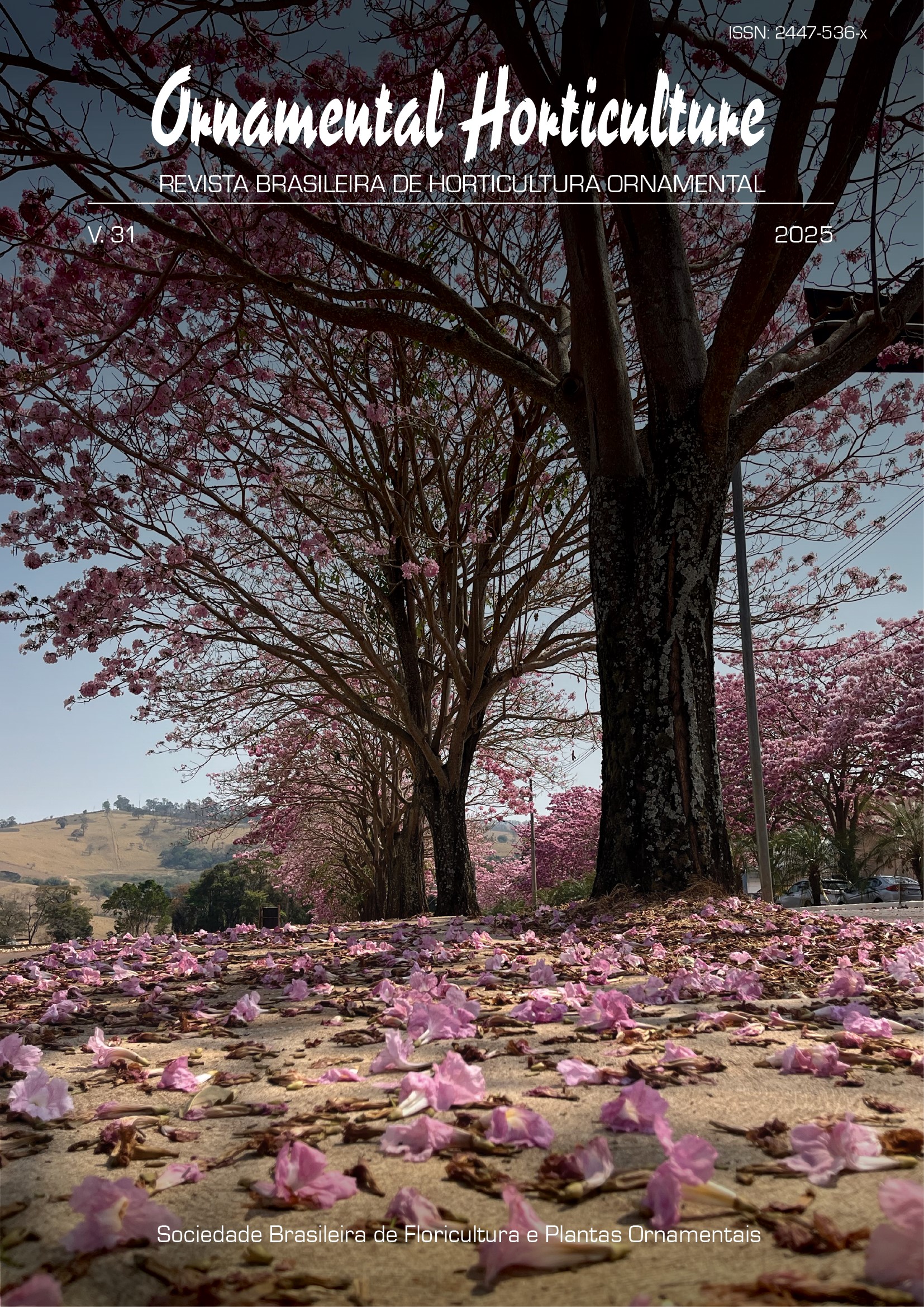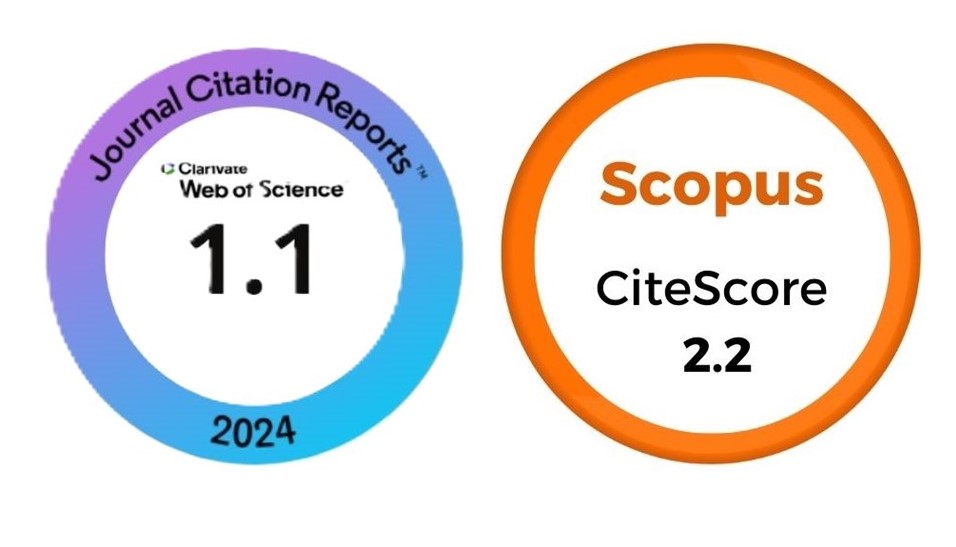Diferenças genômicas e cariotípicas em variedades diploides e tetraploides de rosa-do-deserto
DOI:
https://doi.org/10.1590/2447-536X.v31.e312810Palavras-chave:
bandas CMA/DAPI, conteúdo de DNA, cromocentros, DNA ribossômico, poliploidiaResumo
Adenium (Apocynaceae) é um gênero de espécies suculentas, com caules esculturais e grandes variações nas formas e cores das flores. A maior parte da cadeia de produção mundial consiste em híbridos, e A. obesum (2n = 22) é a espécie com maior interesse ornamental. Adenium obesum e A. arabicum (2n = 44) diferem em suas características morfológicas e são encontrados em áreas geográficas distintas. De acordo com as regras de nomenclatura botânica, A. arabicum deveria ser chamado por A. obesum ou uma variedade dele. No entanto, isso pode ser geneticamente questionável. Embora os dados de variação genética para as rosas do deserto sejam escassos, eles são cruciais para o setor de produção de plantas ornamentais. O objetivo deste estudo foi usar dados de citometria de fluxo, caracterização dos cariótipos e núcleos, porção repetitiva de DNA, bioinformática e localização física de sequências por hibridização in situ, para melhorar a compreensão da diversidade genômica entre variedades diploides e tetraploides de A. obesum. Os cariótipos foram compostos por cromossomos meta e submetacêntricos, e o tamanho dos genomas variou de 2C = 1,98 pg em amostras diploides a 2C = 2,92 pg em amostras tetraploides. O bandeamento cromossômico revelou similaridades entre as variedades, com o acúmulo de bandas de regiões ricas em bases AT (DAPI+) presentes nas regiões cromossômicas intersticiais-proximais, e uma quantidade menor de regiões ricas em bases GC (CMA+). As regiões DAPI+ e CMA+, juntamente com o DNA ribossômico e os retrotransposons Gypsy, predominaram nos cromocentros na interfase. Diferenças na morfologia, número de cromossomos, sinais de hibridização in situ e de redução do valor C do DNA entre esses dois grupos de amostras, reforçam a ideia de que são espécies diferentes e não variedades. Principalmente porque seria muito difícil obter meiose regular a partir do cruzamento de dois conjuntos diferentes de cromossomos. Essas informações são importantes para o melhoramento genético das rosas do deserto.
Downloads
Referências
ASSIS, R.; GONÇALVES, L.S.A.; GUYOT, R.; VANZELA, A.L.L. Abundance of distal repetitive DNA sequences in Capsicum L. (Solanaceae) chromosomes. Genome, v.66, n.10, 2023. https://doi.org/10.1139/gen-2022-0083
BAI, C.; ALVERSON, W.S.; FOLLANSBEE, A.; WALLER, D.M. New reports of nuclear DNA content for 407 vascular plant taxa from the United States. Annals of Botany, v.110, n.8, p.1623-1629, 2012. https://doi.org/10.1093/aob/mcs222
BÁEZ, M.; SOUZA, G.; GUERRA, M. Genome size and cytomolecular diversification in two species of the South African endemic genus Tulbaghia L. (Allioideae, Amaryllidaceae). South African Journal of Botany, v.130, p.407-413, 2020. https://doi.org/10.1016/j.sajb.2020.01.024
BARRETO, L.M.; ASSIS, R.; VANZELA, A.L.L. Chromosomal and genomic data in Neotropical Dorstenia species (Moraceae) and their relationships with African species. Botanical Journal of the Linnean Society, v.202, n.1, p.76- 92, 2023. https://doi.org/10.1093/botlinnean/boac076
BASIT, A. and LIM, K-B. Systematic approach of polyploidy as an evolutionary genetic and genomic phenomenon in horticultural crops. Plant Science v.348, p.112236, 2024. https://doi.org/10.1016/j.plantsci.2024.112236
CINTRA, L.A.; SOUZA, T.B.; PARTEKA, L.M.; BARRETO, L.M.; PEREIRA, L.F.P.; GAETA, M.L.; GUYOT, R.; VANZELA, A.L.L. An 82 bp tandem repeat family typical of 30 non-coding end of Gypsy/TAT LTR retrotransposons is conserved in Coffea spp. pericentromeres. Genome, v.65, n.3, 2021. https://doi.org/10.1139/gen-2021-0045
COLOMBO, R.C.; CRUZ, M.A.; CARVALHO, D.U.; HOSHINO, R.T.; ALVES, G.A.C.; FARIA, R.T. Adenium obesum as a new potted flower: growth management. Ornamental Horticulture, v.24, n.3, p.197-205, 2018. https://doi.org/10.14295/oh.v24i3.1226
DAS, A.B.; MOHANTY, S.; DAS, P. Chromosome number, karyotype, and nuclear DNA content in some Adenium species of the family Apocynaceae. Cytobios, v.98, n.388, p.95-104, 1999.
DIMMITT, M.; EDWARDS, T. Adenium Taxonomy and Nomenclature: Progress Creates More Questions. Cactus and Succulent Journal, v.93, n.4, p.252-266, 2021. https://doi.org/10.2985/015.093.0401
EBRAHIMI, F.; NOHOOJI, M.G.; MIRI, S.M. First karyotype analysis of Nerium oleander populations in Iran. Rostaniha, v.22, n.2, p.186-193, 2021. https://doi.org/10.22092/botany.2021.354571.1246
ENDRESS, M.E.; LIEDE-SCHUMANN, S.; MEVE, U. An updated classification for Apocynaceae. Phytotaxa, v.159, n.3, p.175-194, 2014. http://dx.doi.org/10.11646/phytotaxa.159.3.2
FENG, W.; MICHAELS, S.D. Accessing the inaccessible: The organization, transcription, replication, and repair of heterochromatin in plants. The Annual Review of Genetics, v.49, n.1, p.439-459, 2015. https://doi.org/10.1146/annurev-genet-112414-055048
FERREIRA, D.A.T.; PRAÇA-FONTES, M.M.; VIEIRA, A.T.; NUNES, A.C.P.; CLARINDO, W.R. Karyotype and nuclear DNA content variation in Passiflora L. Scientia Horticulturae, v.272, 109532, 2020. https://doi.org/10.1016/j.scienta.2020.109532
FISHBEIN, M.; LIVSHULTZ, T.; STRAUB, S.C.K.; SIMÕES, A.O.; BOUTTE, J.; MCDONNELL, A.; FOOTE, A. Evolution on the backbone: Apocynaceae phylogenomics and new perspectives on growth forms, flowers, and fruits. American Journal of Botany, v.105, n.3, p.495-513, 2018. https://doi.org/10.1002/ajb2.1067
GUIMARÃES, G.; CARDOSO, L.; OLIVEIRA, H.; SANTOS, C.; DUARTE, P.; SOTTOMAYOR, M. Cytogenetic characterization and genome size of the medicinal plant Catharanthus roseus (L.) G. Don. AoBP Plants, v.2012, p.pls002, 2012. https://doi.org/10.1093/aobpla/pls002
HASSAN, A.H.; MOKHTAR, M.M.; EL ALLALI, A. Transposable elements: multifunctional players in the plant genome. Frontiers in Plant Science, v.14, p.1330127, 2023. https://doi.org/10.3389/fpls.2023.1330127
HASTUTI, D.; SURANTO, S.; SETYONO, P. Variation of morphology, karyotype, and protein band pattern of Adenium (Adenium obesum) varieties. Nusantara Bioscience, v.1, n.2, p.78-83, 2009. https://doi.org/10.13057/nusbiosci/n010205
HESLOP-HARRISON, J.S.; SCHWARZACHER, T.; LIU, Q. Polyploidy: its consequences and enabling role in plant diversification and evolution. Annals of Botany, v.131, n.1, p.1-10, 2023. https://doi.org/10.1093/aob/mcac132
LIEHR, T. Molecular cytogenetics in the era of chromosomic and cytogenomic approaches. Frontiers in Genetics, v.12, p.720507, 2021. https://doi.org/10.3389/fgene.2021.720507
MONTENEGRO, C.; ROA, F.; FILHO, W.S.S.; SILVA, A.E.B. Heterochromatic patterns of Citrus revisited: a new look at species origins and karyotype evolution. Tree Genetics & Genomes, v.19, p.36, 2023. https://doi.org/10.1007/s11295-023-01610-0
MUJIB, A., MAMGAIN, J., BANSAL, Y., EJAZ, E. Interspecific genome size (2C DNA) variation in some ornamental and medicinal plants: Is it a phenomenon of partial sequence amplification or loss? In Genome size and genetic homogeneity of regenerated plants, 2023. p. 327-351.
NOVAK, P.; ROBLEDILLO, L.A.; KOBLIZKOVA, A.; VRBOVA, I.; NEUMANN, P.; MACAS, J. TAREAN: a computational tool for identification and characterization of satellite DNA from unassembled short reads. Nucleic Acids Research, v.45, n.12, p.e111, 2017. https://doi.org/10.1093/nar/gkx257
PELLICER, J.; LEITCH, I. The Plant DNA C-values database (release 7.1). The New Phytologist, v.226, n.2, p.301-305, 2020. https://www.jstor.org/stable/26914539
PRAÇA-FONTES, M.M.; CARVALHO, C.R.; CLARINDO, W.R.; CRUZ, C.D. Revisiting the DNA C-values of the genome size-standards used in plant flow cytometry to choose the ‘‘best primary standards’. Plant Cell Reports v.30, p.1183-1191. 2011. https://doi.org/10.1007/s00299-011-1026-x
RAMAKRISHNAN, M.; SATISH, L.; SHARMA, A.; VINOD, K.K.; EMAMVERDIAN, A.; ZHOU, M.; WEI, Q. Transposable elements in plants: Recent advancements, tools and prospects. Plant Molecular Biology Reports, v.40, p.628-645, 2022. https://doi.org/10.1007/s11105-022-01342-w
SANTOS, V.; SILVA, E.F.; ALMEIDA, C. Genome size and identification of repetitive DNA sequences using low coverage sequencing in Hancornia speciosa Gomes (Apocynaceae: Gentianales). Genetics and Molecular Biology, v.43, n.4, p.e20190175, 2020. https://doi.org/10.1590/1678-4685-GMB-2019-0175
SCHENK, J.J.; BECKLUND, L.E.; CAREY, S.J.; FABRE, P.P. What is the “modified” CTAB protocol? Characterizing modifications to the CTAB DNA extraction protocol. Applications in Plant Sciences, v.11, p.e11517, 2023. https://doi.org/10.1002/aps3.11517
SOUZA, T.B.; GAETA, M.L.; MARTINS, C.; VANZELA, A.L.L. IGS sequences in Cestrum present AT- and GC-rich conserved domains, with strong regulatory potential for 5S rDNA. Molecular Biology Reports, v.47, p.55-66, 2020. https://doi.org/10.1007/s11033-019-05104-y
SOUZA, T.B.; PARTEKA, L.M.; KUOB, Y.; NASCIMENTO, T.; SCHUBERT, V.; PEDROSA-HARAND, A.; MARQUES, A.; HOUBEN, A.; VANZELA, A.L.L. . Distinct patterns of satDNA distribution in holocentric chromosomes of spike-sedges (Eleocharis, Cyperaceae). Genome, v. 68, p. 1-13, 2025. https://dx.doi.org/10.1139/gen-2024-0089
TEMSCH, E.M.; KOUTECKÝ, P.; URFUS, T.; ŠMARDA, P.; DOLEŽEL J. Reference standards for flow cytometric estimation of absolute nuclear DNA content in plants. Cytometry, v. 101, p.710-724, 2022. https://doi.org/10.1002/cyto.a.24495
VAN DER LAAN, F.M.; ARENDS, J.C. Cytotaxonomy of the apocynaceae. Genetica, v.68, n.1, p.3-35, 1985. https://doi.org/10.1007/BF02424563
VIMALA, Y.; LAVANIA, S.; LLAVANIA, U.C. Chromosome change and karyotype differentiation–implications in speciation and plant systematics. Nucleus, v.64, p.33-54, 2021. https://doi.org/10.1007/s13237-020-00343-y
ZONNEVELD, B.J.M.; LEITCH, I.J.; BENNETT, M.D. First nuclear DNA amounts in more than 300 Angiosperms. Annals of Botany, v.96, n.2, p.229-244, 2005. https://doi.org/10.1093/aob/mci170
Downloads
Publicado
Edição
Seção
Licença
Copyright (c) 2025 Ornamental Horticulture

Este trabalho está licenciado sob uma licença Creative Commons Attribution 4.0 International License.








